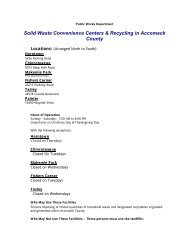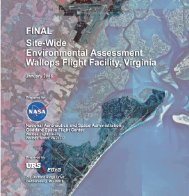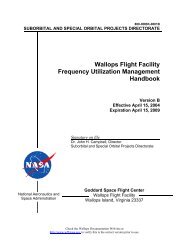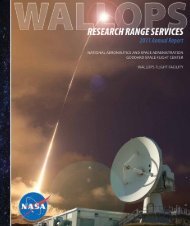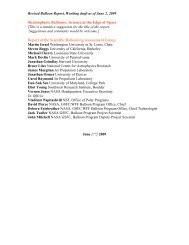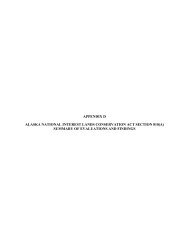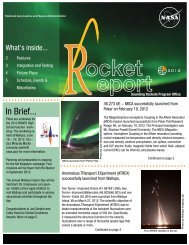Alternative Energy Draft EA - NASA Visitor Center at Wallops Flight ...
Alternative Energy Draft EA - NASA Visitor Center at Wallops Flight ...
Alternative Energy Draft EA - NASA Visitor Center at Wallops Flight ...
You also want an ePaper? Increase the reach of your titles
YUMPU automatically turns print PDFs into web optimized ePapers that Google loves.
Proposed Action and <strong>Altern<strong>at</strong>ive</strong>s<br />
3. Additionally, the potentially available areas of <strong>Wallops</strong> Mainland and <strong>Wallops</strong> Island,<br />
primarily within wetlands, are within the 100-year floodplain and are subject to flooding<br />
and the corrosive effects of nearby marine w<strong>at</strong>ers, which would result in additional<br />
maintenance on the solar panels.<br />
4. There is an insufficient amount of buildings, and therefore rooftop area, <strong>at</strong> <strong>Wallops</strong><br />
Mainland and <strong>Wallops</strong> Island to allow for a majority of the panels to be installed on<br />
rooftops.<br />
Therefore, <strong>NASA</strong> has determined th<strong>at</strong> the solar panels should be installed <strong>at</strong> the WFF Main<br />
Base. The solar panels would not be expected to interfere with WFF’s tracking/telemetry<br />
systems. Other consider<strong>at</strong>ions, listed below, were taken into account in identifying potentially<br />
suitable areas for these wind turbines. The following areas were excluded from the Main Base<br />
for install<strong>at</strong>ion of solar panels:<br />
Areas having moder<strong>at</strong>e and high sensitivity for cultural resources<br />
Wetlands<br />
Impervious surfaces (i.e., buildings, roads, parking lots)<br />
Airfield, runways, taxiways<br />
Areas within a 174-meter (570-foot) buffer adjacent to runways and taxiways (due to glare and<br />
pilot safety)<br />
Areas planned for future structures<br />
Figure 5 shows the potentially suitable areas for install<strong>at</strong>ion of solar panels. The total area<br />
identified is 70 hectares (172 acres).<br />
2.1.1.4 Hydrokinetic Power<br />
Tidal and wave power gener<strong>at</strong>ion are in their technological infancy compared to wind and solar<br />
power, and numerous oper<strong>at</strong>ional limit<strong>at</strong>ions exist as a result. Some of these limit<strong>at</strong>ions include<br />
the need to develop equipment and technology th<strong>at</strong> can withstand destructive factors such as<br />
heavy storms and corrosion, the cost-benefit of m<strong>at</strong>erials and install<strong>at</strong>ion versus energy output,<br />
and the rel<strong>at</strong>ively undocumented effects on ocean life.<br />
Description of Tidal Power<br />
Tidal power utilizes the movement of w<strong>at</strong>er caused by tidal currents, and uses equipment similar<br />
to wind turbines, turning like windmills in the current. W<strong>at</strong>er’s gre<strong>at</strong>er density means fewer and<br />
smaller turbines are needed to produce the same amount of electricity as wind turbines. Although<br />
tidal power is more predictable than wind and solar power, it is a rel<strong>at</strong>ively unproven technology<br />
with questionable economic viability on a small scale, which would be the case <strong>at</strong> WFF.<br />
Description of Wave Power<br />
Wave power differs from tidal power in th<strong>at</strong> electricity gener<strong>at</strong>ors are placed on the surface of<br />
the ocean. <strong>Energy</strong> output is determined by wave height, wave speed, wavelength, and w<strong>at</strong>er<br />
density. Two of the three basic methods to harness wave power include the buoy method and the<br />
hinged contour device, which use a special flo<strong>at</strong>ing device th<strong>at</strong> rises and falls along with the<br />
17




